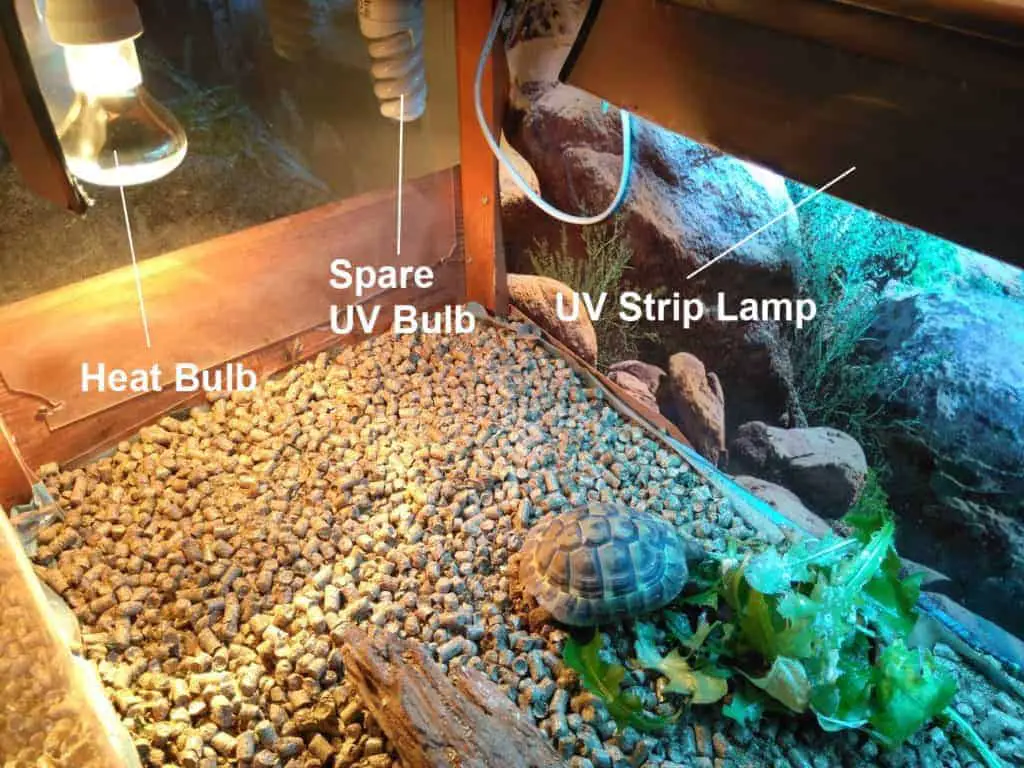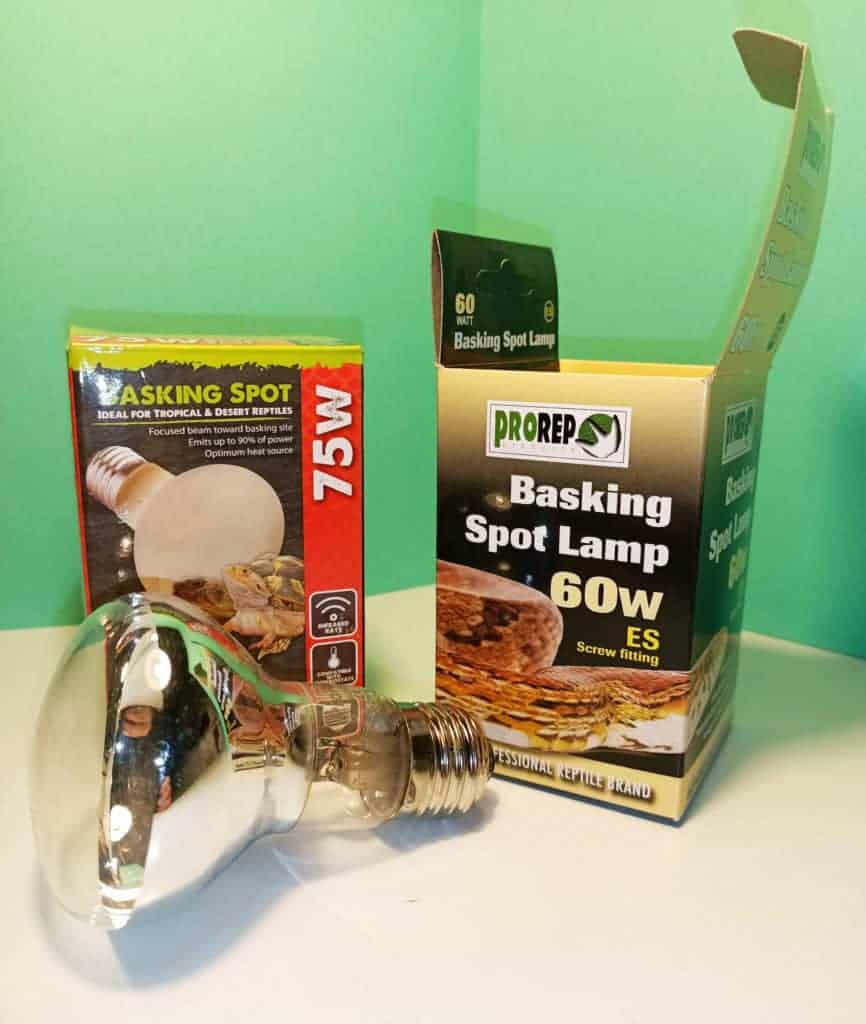
Tortoises require light sources to provide both heat and ultraviolet light. Both are important, but the key distinction is that the UV light should pretty much fill the entire space in the vivarium or tortoise table, whereas the heat lamp only needs to be positioned in one corner.
The reason for this is that your juvenile tortoise needs a constant dose of UV in order for him or her to synthesise vital vitamin D3, whereas heat is only needed when the tortoise wishes to bask to warm up, which isn’t essential at all times.
So in terms of a basic arrangement – for heat, a heat bulb at one end of the enclosure, preferably at the opposite end to the covered ‘hide’ area works best so that the tortoise can escape from the heat and light of the heat bulb when he or she wishes.

For ultraviolet light, the biggest strip lamp you can fit into your enclosure is best, so that the whole area is flooded with light at all times. You might find, as I did, that your tortoise table comes supplied with a small UV bulb, the same sort of size as the heat bulb. I don’t believe this is anywhere near adequate, so I would always recommend fitting a strip lamp instead. You can then use the smaller bulb as a back up when the strip lamp blows (which it will!) in the meantime before you’re able to replace it.
What Type of Heat Bulb Should I Use?

There are a few options on the market as far as keeping your tortoise warm goes, from non light emmiting ceramic emitters to heat mats. Quite honestly though these are pretty expensive options, and they require greater considerations in terms of space and installation. Plus ceramic heaters can get extremely hot, so you need to be particularly careful about how you install them.
Personally I prefer the sunlight replicating nature of halogen or incandescent light bulbs, to me it just feels like the more natural option. I use a 60 Watt basking lamp positioned about 30cm above the tortoise, and he quite happily basks under it as and when he chooses throughout the day.
What type of UV Bulb Should I Use, and How Should I Position it?
As mentioned above, UV bulbs should be the long ‘strip’ variety, and as long as you can fit in to the available space. It’s important to choose a UV bulb that emits a particularly high level of UVB light as well as UVA light.
Aim to position your UV bulb high up in the enclosure so that it has good coverage across the entire floor space.
I’ve also chosen to put a ‘sunshade’ over my UV bulb, this doesn’t obstruct the light from reaching the tortoise, but it does save the eyes of any person in the vicinity. I’m not too sure what the implications of constantly staring into a UV bulb might be, but I’ve chosen not to risk it to find out.
My UV bulb requires the use of a large power supply with a ‘starter’ module, so you’ll need to account for where you plan to position this. These are quite lumpy, in my case about 25cm long by 7cm wide, by 5cm tall.
How Many Hours of Lighting do Tortoises Need?
The general rule is that juvenile tortoises need to have 8 to 10 hours of both heat and ultraviolet light available to them per day. This explains (as you’ll find out if you haven’t already) why both UV and basking light bulbs have a nasty habit of failing every 6 to 12 months, but unfortunately there isn’t really any way around this.
How Long Can a Juvenile Tortoise Safely go Without Heat?
If you need to transport your tortoise for any reason, or place them outside of their enclosure for a short while whilst cleaning it, then they won’t suffer any adverse health effects. Other than short absences like this however, juvenile tortoises shouldn’t be kept away from their heat and UV sources for long.
Whilst lack of UV for a few hours won’t be an issue I would certainly look for an alternative form of heat if you suffer a power cut for example. A hot water bottle filled from the tap could be a useful stop gap to use if you know you’re going to be without power for a while.
Do Tortoises Need a Heat Lamp at Night?
My own personal view is that no lighting is required for a tortoise at night time provided the ambient temperature of your home is a reasonable room temperature of 21 degrees or so.
Some people advocate the use of soft blue lighting at night, but I can’t see how this is useful at all. Tortoises are just like us in as much as they sleep better in darkness, just as they would in the wild.
If you are concerned about the temperature dropping too low at night then you might have a good case for a non light emitting heat source such as a ceramic heat fitting or a heat mat. A heat mat is probably the better option at night as they tend to emit a gentle warmth (which can usually also be adjusted) over a large area (ie. under the belly of where the tortoise is sleeping) rather than the intense heat of a ceramic fitting which is almost certainly too much for night time.
Do Tortoises Require Heat and UV Lamps For Their Whole Lives?
This is a subject of some debate, with some people claiming that older tortoises don’t need additional light and heat sources once they’re older.
I vehemently refute this claim with the simple fact that UV in particular is always required to maintain a healthy shell and skeleton regardless of age. Just like us, tortoises regenerate tissues and bone throughout their lives, not just when they are growing to maturity, so it’s important to facilitate this regeneration throughout their lives.
I believe the confusion over this subject arises from the fact that once they’re older tortoises are able to roam more, and may even live outside during the summer. If they’re able to receive enough natural sunlight by this means, then of course no additional source of UV is required.
The reason juveniles require a constant artificial source of UV at all times is because they’re contained in a tortoise table or terrarium which stays in the same place, typically away from natural light.
As far as heat goes, this is less clear. From the age of two onwards it’s safe to allow your tortoise to live outside in an enclosure during the summer months, but clearly at times this means they won’t be exposed to the same level of heat that they would in their nice warm heated indoor enclosure, so would it be safe to assume consistent heat exposure is less important than UV exposure? I’m not sure, but I would certainly keep hold of your heat lamp for those colder days when your tortoise is living indoors, or when ‘over wintering’.

